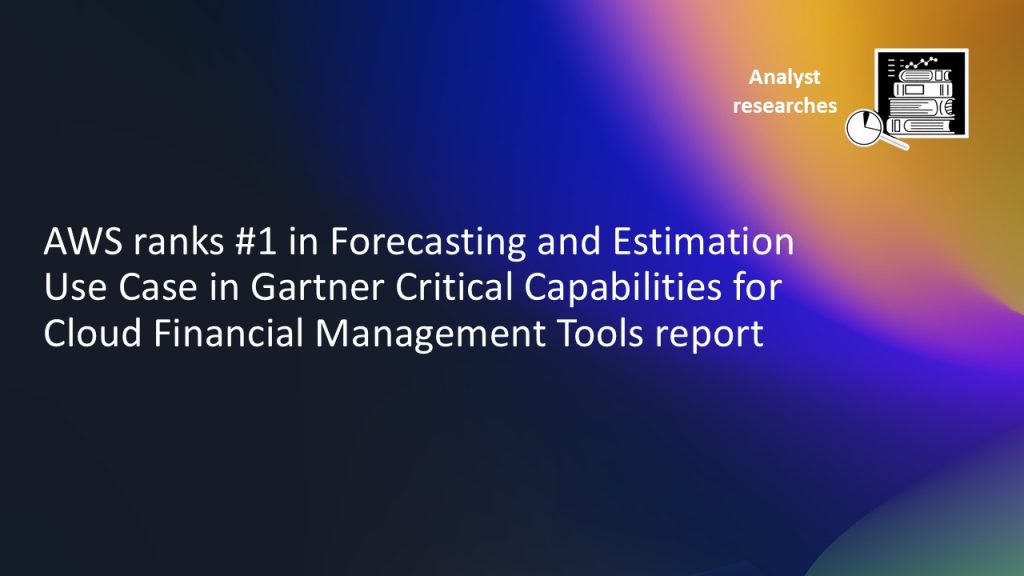AWS Cloud Financial Management
Category: Thought Leadership
Updated Cloud Financial Management Digital Training Courses with a New Course Added: “FinOps for GenAI”
AWS is committed to empowering the FinOps community with the knowledge, tools, and best practices needed to excel in cloud financial management. Our dedication to the FinOps community goes beyond providing world-class cloud services—we’re invested in your professional growth and success. Through our comprehensive digital training portfolio, we aim to equip FinOps professionals with the expertise needed to drive meaningful cost optimization, establish effective governance frameworks, and demonstrate clear business value from cloud investments. Today, we’re excited to share updates to our Cloud Financial Management training courses and introduce a specialized new course designed specifically for the growing demands of generative AI cost management.
AWS ranks #1 in Forecasting and Estimation Use Case in Gartner Critical Capabilities for Cloud Financial Management Tools report
A cloud vendor’s Cloud Financial Management (CFM) capabilities are crucial for your success in the cloud. Whether you’re planning future investments, optimizing current spending, or allocating costs across your organization, having the right CFM tools makes all the difference. AWS is proud to be recognized with the 1st place in forecasting and estimation use case, and top 3 in driving cost efficiency use case and promotion accountability use case in the latest 2025 Gartner Critical Capabilities for Cloud Financial Management Tools research.
Optimizing Cost for Generative AI with AWS
If you or your organizations are in the midst of exploring generative AI technologies, it’s important for you to be aware of the investment that comes with these advanced applications. While you are aiming at the expected return on your generative AI investment, such as, operational efficiency, increased productivity, or improved customer satisfaction, you should also have a good understanding of levers you can use to drive cost savings and enhanced efficiency. To guide you through this exciting journey, we will publish a series of blog posts filled with practical tips to help AI practitioners and FinOps leaders understand how to optimize the costs associated with your generative AI adoption with AWS.
10 Ways to work WITH Developers to take action with FinOps/Cost Optimization
When FinOps Practitioners share recommendations for cost optimization, they can often be met with a “No”, a “I can’t right now”, or “It’s not my priority” from a Developers (Devs). According to the FinOps Foundation’s “State of FinOps 2023” report, the number one pain point was getting engineers to take action. But, I am here to say, “it’s not the Devs fault!” We spoke with customers who have overcome this roadblock and want to share the lessons learned with you! This blog will walk through 10 ways you can work with your engineers to establish a FinOps culture at your organization.
Establish a cloud financial management “flywheel” to continuously improve cost transparency, control, forecasting, and optimization
Read this blog and learn how you can establish effective cloud financial management (CFM) practices to continuously improve cost transparency, control, forecasting, and optimization.
Understand your AWS bill with the right cost allocation strategy
Effective cost tracking and allocation is crucial to operating in the cloud. With the right strategies and AWS tools, you can access and provide cost and usage data that aligns with your business objectives, helping you manage and optimize your cloud spend with increased understanding and accountability across your AWS bill. Learn about and see cost allocation strategies in action to help you understand your AWS bill.
The benefits of cloud adoption in the life sciences industry
Life sciences organizations are grappling with increased competition and the need to maintain profitability, while navigating a complex regulatory environment. To tackle these challenges, many are migrating to the cloud to accelerate innovation and enhance productivity. The Hackett Group evaluated the business benefits and trends of cloud adoption for life sciences organizations.
AWS Cloud Financial Management 2023 Q1 recap
The uncertainty of the world economy has once again emphasized the importance of resource efficiency. Take a look at the latest enhancements of the AWS Cloud Financial Management suite of products and learn how you can incorporate these in your daily CFM process.
ICYMI: Increase cost visibility, optimization, and overall CFM maturity
Check out these resources to learn how you can optimize cloud costs, increase cost visibility, establish your organizational CFM framework, implement automation, and understand what strategies contribute to the success of cloud-mature enterprises.
Telenor simplifies data access and control with Row Level Security
In some cases, users can be hindered with access to all available cost data for an organization. With Row Level Security (RLS), you can restrict the data a user can see to a subset of the business most relevant to them. In this blog, we’re going to walk you through how Telenor implemented RLS on its Multi-Payer Cost Dashboards, and how you can, too.









